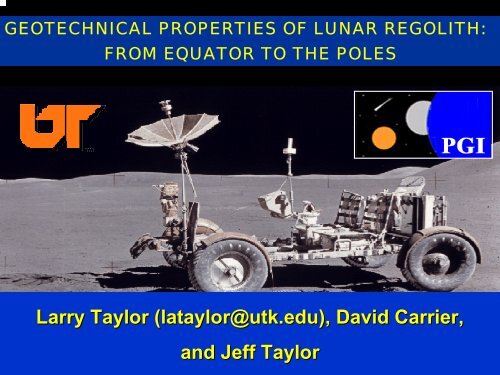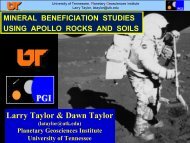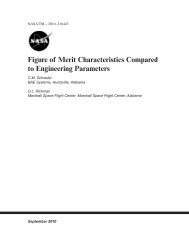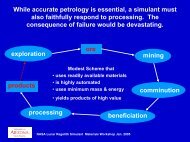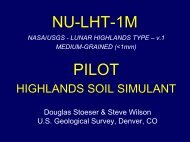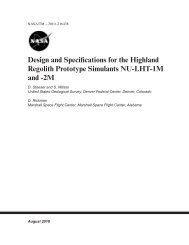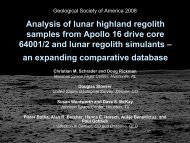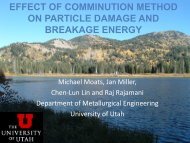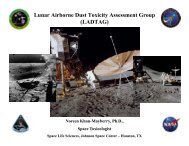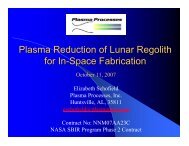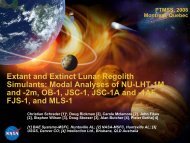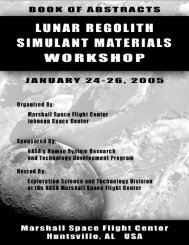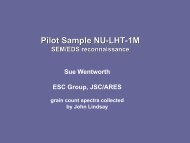Larry Taylor (lataylor@utk.edu), David Carrier, and Jeff Taylor - Nasa
Larry Taylor (lataylor@utk.edu), David Carrier, and Jeff Taylor - Nasa
Larry Taylor (lataylor@utk.edu), David Carrier, and Jeff Taylor - Nasa
Create successful ePaper yourself
Turn your PDF publications into a flip-book with our unique Google optimized e-Paper software.
GEOTECHNICAL PROPERTIES OF LUNAR REGOLITH:<br />
FROM EQUATOR TO THE POLES<br />
<strong>Larry</strong> <strong>Taylor</strong> (<strong>lataylor@utk</strong>.<strong>edu</strong>(<br />
<strong>lataylor@utk</strong>.<strong>edu</strong>), <strong>David</strong> <strong>Carrier</strong>,<br />
<strong>and</strong> <strong>Jeff</strong> <strong>Taylor</strong>
L.A. <strong>Taylor</strong> – LSSW<br />
Moon is an enormous Earth-orbiting Space Station,<br />
A natural satellite outside of Earth’s gravity well,<br />
With raw materials that can be put to practical use<br />
As humanity exp<strong>and</strong>s outward into the Solar System.<br />
OUTLINE<br />
♦ REVIEW CHARACTERIZATION OF LUNAR SOIL<br />
♦ UNIQUE PROPERTIES OF LUNAR SOIL<br />
♦ CONSIDERATIONS FOR THE SOUTH POLE<br />
♦ SCI / ENGR PROPERTIES OF LUNAR SOILS<br />
♦ PREFACE TO NEEDS FOR LUNAR SOIL SIMULANTS
L.A. <strong>Taylor</strong> – LSSW<br />
Impact-Glass<br />
Bead<br />
Lunar Mare Soil<br />
Volcanic Glass<br />
Bead<br />
Agglutinate<br />
Rock<br />
Chips<br />
Impact<br />
Glass<br />
Plagioclase<br />
1 mm<br />
Regolith: broken up rock material; Soil:
Lunar Soil Formation<br />
Comminution, , Agglutination, & Vapor Deposition<br />
L.A. <strong>Taylor</strong> – LSSW<br />
The major Weathering <strong>and</strong> Erosional agent on the<br />
Moon is Meteorite <strong>and</strong> Micrometeorite Impact.
L.A. <strong>Taylor</strong> – LSSW<br />
Mare-Soil<br />
Agglutinate<br />
100 µm<br />
Courtesy – Dave McKay<br />
Pieces of minerals, rocklets, <strong>and</strong> glass<br />
welded together by shock-melt glass
SEM BSE-Image of Mare Agglutinitic Glass<br />
Milky Way of<br />
Nano-sized Fe o<br />
1 µm<br />
L.A. <strong>Taylor</strong> – LSSW<br />
Courtesy – Dave McKay
Cumulative Modal Abundances of Mare Soils<br />
Low-Ti Mare Soils<br />
15071-52 15041-94<br />
12030-14 12001-56<br />
High-Ti Mare Soils<br />
71501-35 10084-78<br />
71061-14 70181-47 79221-81<br />
TiO 2<br />
100<br />
= 3.6 1.6 2.8 1.7 7.3 9.5 8.1 7.3 6.5<br />
80<br />
Others<br />
Vol.Gl.<br />
60<br />
Olivine<br />
Ilm<br />
40<br />
Plag<br />
20<br />
Px<br />
Aggl Gl<br />
0<br />
20-45 µm<br />
10-20 µm<br />
Particle Size Distribution<br />
Fig. 9.1 (LSB, 1991); Distribution of particle sizes in separate splits of<br />
Apollo 17 soil 78221,8, analyzed by 3 different labs.<br />
Particle Size (µm)<br />
Cumulative Percent Probability Scale<br />
Apollo 17 Soil<br />
Sample 78221,8<br />
φ<br />
φ<br />
McKay et al., 1974<br />
L.A. <strong>Taylor</strong> – LSSW
Diagram showing the relationship between grain size, sorting, <strong>and</strong><br />
agglutinate content for 42 Apollo 17 soils (McKay et al, 1974)<br />
L.A. <strong>Taylor</strong> – LSSW
Weight Distribution<br />
Table 9.1 (LSB, 1991); Weight distribution in size fractions of<br />
scooped surface soils.<br />
Size Fraction<br />
Mean Size, M z<br />
Soil >1 cm 4-10 mm 2-4 mm 1-2 mm
MAGNETIC PROPERTIES<br />
OF LUNAR SOILS<br />
Magnetic Susceptibility of Soil Particles<br />
Increases as Grain Size Decreases;<br />
Effects of Vapor-Deposited Nanophase Fe o are a<br />
Direct Function of Surface Area <strong>and</strong> Most<br />
Pronounced in the Finest Grain Sizes;<br />
Virtually All
Lunar Dust Effects: Must be Addressed<br />
before any Commercial Presence<br />
on the Moon can be Fully Evaluated.<br />
Potential for coatings, on seals, gaskets, optical lens,<br />
windows, electrical components, et cetera;<br />
Abrasiveness, with regards to friction-bearing surfaces;<br />
Potential for settling on all thermal <strong>and</strong> optical surfaces,<br />
such as Solar cells <strong>and</strong> mirrors; <strong>and</strong><br />
Physiological effects on humans, especially with respect<br />
to the lungs, the lymph system, <strong>and</strong> potentially the<br />
cardiovascular system, in the case of extremely fine<br />
particles.<br />
SOLUTION: Magnetic brushes
L.A. <strong>Taylor</strong> – LSSW<br />
MICROWAVE PROCESSING OF LUNAR SOIL<br />
SINTERING <strong>and</strong> MELTING<br />
Creating Smooth-Sintered to Glassy Surfaces on the Moon<br />
Microwave Source<br />
Primary Cone<br />
of Microwaves<br />
Parabolic<br />
Metal<br />
Reflector
MICROWAVE PROCESSING OF LUNAR SOIL<br />
SINTERING <strong>and</strong> MELTING<br />
Roads<br />
Satellite Dishes<br />
Shielding<br />
Welding<br />
Recovery of Volatiles<br />
Glass Fiber Production<br />
Solar Cells (Ilmenite)<br />
SUGGESTIONS <br />
L.A. <strong>Taylor</strong> – LSSW
Potential Sources of Polar Hydrogen<br />
Solar-wind deposited<br />
H 2 O-ICE (in addition to solar-wind H 2 )<br />
Impact of Comets<br />
Impact of hydrous Meteorites<br />
KEY POINT: Still an Unknown!<br />
(<strong>and</strong> LRO will not provide definitive answer)<br />
L.A. <strong>Taylor</strong> – LSSW
Cometary Gases<br />
We do not have solid data on composition<br />
of polar volatile deposits;<br />
A good guess is that they contain<br />
gases from comets. For example, in<br />
Hale Bopp:<br />
H 2 O: 100 CO 2 : 6<br />
CO: 20 NH 3 : 0.7<br />
CH 3 OH: 2 CH 4 : 0.6<br />
These could result in deposits of H 2 O<br />
<strong>and</strong> other gases.<br />
L.A. <strong>Taylor</strong> – LSSW
H 2 O Deposition as Amorphous Ice<br />
Numerous H 2 O<br />
phases;<br />
At low < 70 K &<br />
P < 2 x 10 8 Pa,<br />
H 2 O occurs as<br />
an amorphous<br />
solid phase;<br />
L.A. <strong>Taylor</strong> – LSSW
L.A. <strong>Taylor</strong> – LSSW<br />
Gas Release from Amorphous Ice<br />
Amount of trapped gas depends on T<br />
Can be up to 3.3 X more gas in ice at 20 K<br />
(Laufer et al., 1987);<br />
Trapped CH 4 /Ice <strong>and</strong> CO/Ice are ~ 0.01 at 70 K.<br />
Gas begins to be released at 120 K <strong>and</strong><br />
increases exponentially as T rises to 135 K;<br />
Transformation to crystalline ice is exothermic,<br />
so there could be a runaway effect,<br />
resulting in huge gas losses.
Agglutinate Properties: Normal Dry Moon<br />
100 µm<br />
50 µm<br />
L.A. <strong>Taylor</strong> – LSSW
Agglutinate Properties: Icy Moon<br />
AGGLUTINATES FORMED IN ICY REGOLITH MIGHT BE EXTREMELY FROTHY!<br />
Sample of RETICULITE: basaltic pumice in which cell walls of<br />
bubbles have burst—leaves a honeycomb-like structure..<br />
L.A. <strong>Taylor</strong> – LSSW
Agglutinate Properties: At an Icy Pole<br />
• Extremely porous agglutinates might lead to<br />
change in physical properties of bulk regolith:<br />
– Agglutinates make up > 50% of a mature soil;<br />
– Agglutinates are substantially weaker to both<br />
compressive <strong>and</strong> tensional forces;<br />
– Frothy Agglutinates would crush easier than ‘normal’<br />
ones, leading to a finer-grained soil;<br />
– Net result would be substantially more glass for<br />
greater grain-to-grain friction.<br />
• Could provide places for H 2 O to precipitate<br />
L.A. <strong>Taylor</strong> – LSSW
L.A. <strong>Taylor</strong> – LSSW<br />
Polar Ice:<br />
Extraction <strong>and</strong> Purification<br />
Once ice deposits are identified <strong>and</strong> characterized,<br />
extraction experiments are needed:<br />
♣<br />
♣<br />
♣<br />
♣<br />
♣<br />
♣<br />
♣<br />
Heating methods<br />
Volatile h<strong>and</strong>ling<br />
Further processing of other gases<br />
Gas storage<br />
Separation of impurities from<br />
Electrolysis of H 2 O to produce LLH <strong>and</strong> LUNOX<br />
Demonstration Experiments on the Moon<br />
<strong>Jeff</strong> <strong>Taylor</strong><br />
Space Resources Roundtable VI
Polar Ice<br />
<br />
Effects of Ice on Regolith Physical Properties<br />
♠ Composition of Ice: Cometary Lunar<br />
♠ Ice form: Crystalline Amorphous Thin films Pore-filling;<br />
♠ Soil Particles: Binding by Ice Loose Granular<br />
Coherent<br />
♠ Geotechnical Properties: variations with depth (drill cores)<br />
Ice Properties!<br />
♠ Physical Properties of Regolith: cohesion, shear strength,<br />
grain-size distribution, bulk density, porosity, etc.<br />
L.A. <strong>Taylor</strong> – LSSW
In non-polar regions:<br />
• Regolith is fine-grained<br />
• Roughly:<br />
– 10% smaller than 10 µm<br />
– ~50% less than 50 µm<br />
• Predictable physical<br />
properties (porosity,<br />
thermal conductivity,<br />
shear <strong>and</strong> bearing<br />
strength, angle of repose,<br />
tribology)<br />
Regolith Grain Size<br />
L.A. <strong>Taylor</strong> – LSSW<br />
But, AT THE POLES<br />
<strong>Carrier</strong> et al. (1991)
The Lunar Bible<br />
Cambridge<br />
University<br />
Press (1991)<br />
L.A. <strong>Taylor</strong> – LSSW
Lunar Soil Properties<br />
L.A. <strong>Taylor</strong> – LSSW<br />
Specific Gravity: Range from 2.3 to >3.2; recommend 3.1 for<br />
Engr/Sci use.<br />
Bulk Density: top 15 cm = 1.45-1.55 g/cm3; avg = 1.50 ±0.05 g/cm3<br />
0-30 cm = 1.53-1.63 g/cm3; avg = 1.58 ±0.05 g/cm3<br />
30-60 cm = 1.69-1.79 g/cm3; avg = 1.74 ±0.05 g/cm3<br />
0-60 cm = 1.61-1.71 ±0.05 g/cm3; avg = 1.66 ±0.05 g/cm3<br />
values up to 1.9 g/cm3 estimated at depth of cores to 2.98 m<br />
Soil Porosity<br />
Depth Range (cm) Average Porosity n,<br />
(%)<br />
Average Void<br />
Ratio, e<br />
0-15 52 ±2 1.07 ± 0.07<br />
0-30 49 ±2 0.96 ± 0.07<br />
30-60 44 ±2 0.78 ± 0.07<br />
0-60 46 ±2 0.87 ± 0.07<br />
Lunar soil, >30 cm, has extremely high relative density<br />
[~90%], more than that which can be produced with<br />
mechanical compaction equipment !<br />
– the lunar soil has experienced slow shaking over eons of time -
L.A. <strong>Taylor</strong> – LSSW<br />
Compressibility:<br />
Lunar soil is slightly more compressible than most simulants (except<br />
JSC-1), regardless of whether two soils are compared at the same void ratio or<br />
relative density - agglutinates.<br />
Shear Strength (cone penetrometer measurements):<br />
Mohr-Coulomb Equation: τ = c + σ tan φ<br />
Friction Angle φ : 40-50 o<br />
Cohesion c : 0.1-1.0 kPa<br />
σ : normal stress (kPa)<br />
Bearing Capacity:<br />
Fig. 9.36 (LSB, 1991) Ultimate<br />
bearing capacity data for lunar<br />
surface material. Data are<br />
plotted in terms of the applied<br />
stress (horizontal axis)<br />
produced by an object on the<br />
lunar surface <strong>and</strong> the footing<br />
width (essentially the footpad<br />
size) of the object.
Slope Stability ( Fig. 9.39; LSB, 1991 )<br />
Calculated stability of artificial<br />
slopes constructed in lunar<br />
surface material. Data are<br />
presented for 3 situations:<br />
(1) an excavation in lunar soil<br />
(2) a compacted pile of<br />
excavated lunar soil;<br />
(3) a dumped pile of lunar soil<br />
A vertical cut can safely<br />
be made in lunar soil to a<br />
depth of about 3 m; m<br />
an excavated slope of 60°<br />
can be maintained to a<br />
depth of about 10 m. m<br />
Slope Height, h (m)<br />
10<br />
3<br />
h<br />
Excavated<br />
F.S.*=1.5<br />
Compacted<br />
F.S.=1.5<br />
b<br />
1 β<br />
*Factor of Safety<br />
Dumped (angle<br />
of repose) F.S.=1.0<br />
Slope Angle, β<br />
90° 80° 70° 60° 50° 40°<br />
Slope Ratio, b=cot β<br />
L.A. <strong>Taylor</strong> – LSSW
<strong>David</strong> <strong>Carrier</strong><br />
JSC,1971<br />
LUNAR SOIL TEST BED<br />
Kaolinite Clay<br />
+<br />
League City S<strong>and</strong><br />
with<br />
C-Black Markers<br />
L.A. <strong>Taylor</strong> – LSSW
Comparison of Apollo Core Bits<br />
L.A. <strong>Taylor</strong> – LSSW<br />
( NASA-S-71-3961-S )
Drive-Tube Core Tube<br />
driven into<br />
Lunar soil simulant<br />
L.A. <strong>Taylor</strong> – LSSW
APOLLO 15 DRILL BIT<br />
L.A. <strong>Taylor</strong> – LSSW<br />
Stem With Helical Fluting for Augering
L.A. <strong>Taylor</strong> – LSSW<br />
APOLLO DRILLING PRACTICE
Don Burnett’s Neutron-Flux Experiment<br />
L.A. <strong>Taylor</strong> – LSSW
L.A. <strong>Taylor</strong> – LSSW<br />
APOLLO 15<br />
Backup Motorcycle
L.A. <strong>Taylor</strong> – LSSW<br />
SOIL PROPERTIES NEEDED FOR DIFFERENT PROCESSING<br />
CHEM-<br />
ISTRY<br />
GRAIN<br />
SIZES<br />
MINER<br />
-ALS<br />
MAGNET-<br />
ICS<br />
ELECTRO-<br />
STATICS<br />
GEOTECH-<br />
NICS<br />
Construction (sintering,<br />
melting,explosives)<br />
X X <br />
Regolith Excavation <strong>and</strong><br />
H<strong>and</strong>ling<br />
X X <br />
Trafficability (e.g., road<br />
building)<br />
X X <br />
Microwave Processing X X X <br />
Conventional Heat Treatment X X <br />
Oxygen Production (several<br />
processes + mineral<br />
beneficiation)<br />
Kg<br />
X X X <br />
Dust Abatement (includes<br />
tribology)<br />
X X X X X <br />
Metals Extraction (several<br />
processes)<br />
X X X X X <br />
Solar-Wind Gas Extraction X X X X <br />
Cement Manufacture X X <br />
Radiation Protection X X <br />
Biological Activity - Toxicity X X X <br />
Biol. Act. - Agriculture X X X
TIME FOR ANOTHER WALK ON THE MOON<br />
L.A. <strong>Taylor</strong> – LSSW<br />
NASA PHOTO


